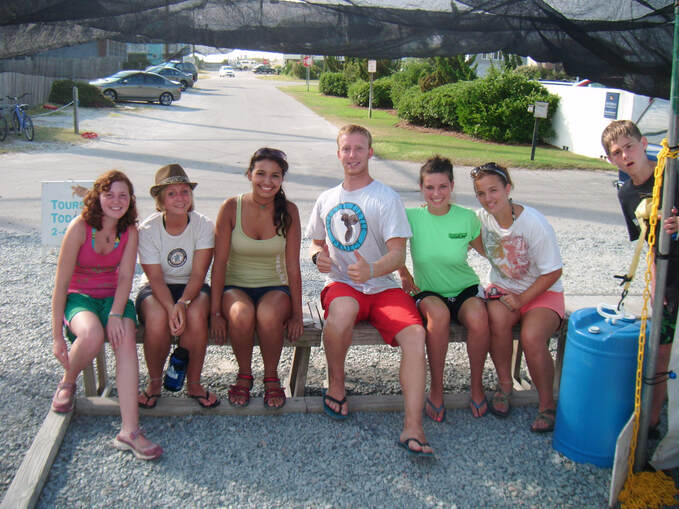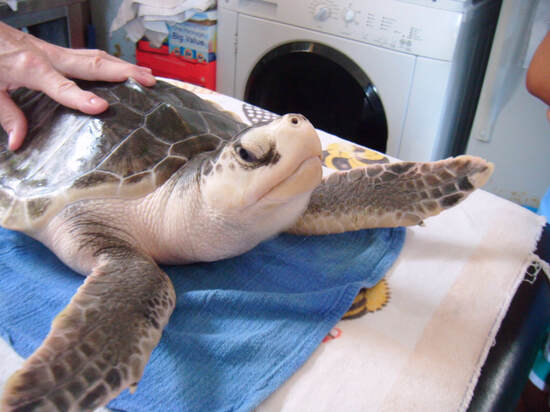Kayla GoforthPh. D UNC - Department of Biology After witnessing a sea turtle nest excavation at just six years old, where I helped a sea turtle hatchling make its way from the nest to the ocean, I was convinced that I was going to become a marine biologist. I did science fair projects on sea turtle biology, continued to grow my seashell collection, and read every book I could find about the ocean. By the time I reached high school and began looking at colleges, particularly ones that offered marine biology programs, my parents thought it might be a good idea for me to see if I really and truly loved marine biology before I spent the next four years of my life studying it. However, because we lived in New York, nowhere near the coast, it was a little difficult to explore marine biology in my hometown. Luckily, North Carolina, a favorite vacation spot of our family, offered a lot of marine science summer camps. It was the perfect solution – my family could vacation and I could immerse myself in marine biology! The summer before my junior year of high school, I attended Marine Quest through UNCW. While my family relaxed and boogie boarded at the beach, I went to camp and learned about salt marshes, intertidal zones, and marine invertebrates. Visit to UNC 2009; Photo Credit: Pam Goforth I loved it, and never wanted the camp to end. On the drive home that year we stopped by the UNC campus, although little did I know I’d be spending a significant amount of time there in the future.  A few months after the Marine Quest camp, my mom called me into her office one day, and said, “Hey, look at this camp, would you be interested in this one for next summer?” I looked at her screen and on it were the words ‘Sea Turtle Camp’. Before even reading or looking at anything else on the website, I immediately screeched “YES!!” The following summer my mom and I packed up our green minivan and once again drove from the frozen tundra of upstate New York down to North Carolina where she dropped me off for a week of Sea Turtle Camp. Photo Credit: Sea Turtle Camp Team  The main highlight of turtle camp was that we would be working at the Karen Beasley Sea Turtle Hospital, assisting with turtle care and maintenance. At the time, the sea turtle hospital was just a garage that had been converted into a turtle rehabilitation center (Photo 2). On the first day of camp, when we went to the turtle hospital for our orientation so to speak, I was shocked by the huge line wrapping outside the garage structure and down the street; despite the humble appearance of the turtle hospital, everyday hordes of people went to visit the sea turtles. Inside the turtle hospital was filled wall to wall with big, circular, blue tanks, and pipes running from one tank to the next. In every tank there was a turtle – green, loggerhead, and Kemp’s ridley turtles of all sizes and states. One large loggerhead turtle had three huge metal braces across its shell, or rather carapace; it had been struck by a boat. The cut across the carapace was so deep that I could see the contraction and expansion of the lungs through the cut. A small green turtle in another one of the tanks had a condition known as ‘bubble butt’. Photo Credit: Sea Turtle Camp Team Bubble butt is when a turtle gets gas stuck in its digestive track, sometimes as a result of a boat strike, and this extra ‘bubble’ of gas prevents the turtle from being able to dive or remain submerged for long. If the turtle tries to dive, the turtle often floats to the surface tail first as the digestive track of the turtle is towards the tail, giving the illusion of the turtle’s butt sticking out of the water. Hence, bubble butt. Other turtles had fishing hook injuries, blocked digestive tracks from plastic ingestion, or cuts across their flippers and shells. I was mesmerized as I walked through the hospital, because I had never been so close to such large turtles. I was also amazed at their resilience – some of these turtles had been severely damaged, and yet, they were all recovering, and would eventually be released.  Throughout the remainder of camp, we visited the turtle hospital nearly every day to work with the turtles. One of the days I fed the large, blind, loggerhead sea turtle that lived at the hospital. Because she was blind, the turtle would remain in captivity the rest of her life, but she was quite resourceful and had adapted to living without eyesight in clever ways. To feed her, I had to carefully drop the food – a delectable mix of squid and fish – into the center of the tank. The turtle would then move her flippers in a sweeping motion as she spun herself in a circle, causing all of her food to move towards the edges of the tank. When the food was on the edges of the tank, the blind turtle could nose along the walls of her tank and eat all the food there. Photo Credit: Sea Turtle Camp Team Another day, I helped rebandage a small Kemp’s Ridley turtle with an injury to its carapace. I helped hold the turtle down as we took off the first bandage, and then reapplied betadine to the cut and a new bandage. Bandaging a Kemp’s Ridley sea turtle;  I was even fortunate enough to meet Jean Beasley, the director of the turtle hospital, one day while working at the hospital (Photo 4). I should mention that we also did some of the inglorious work like scrubbing tanks and mopping the floors, but I was happy as a clam to do any of it. When not working at the Karen Beasley Sea Turtle Hospital, we were learning how to promote sea turtle conservation every day. There are simple things we can choose to do, like taking re-useable bags to the grocery store, or supporting organizations that give back to turtle conservation, that are everyday actions that help conserve sea turtles, and these actions are equally as crucial to sea turtle conservation as sea turtle hospitals. The central conservation message at camp was about limiting plastic use as much as possible, because plastic is a monumental threat to sea turtles. This message was delivered in two ways: 1) by a beach clean-up where we witnessed just how much trash is left on beaches, and 2) from a research scientist who studied plastic pollution firsthand. The scientist told us about the Great Pacific Garbage Patch, a large mass of plastic floating in the center of the Pacific Ocean. Outside the turtle hospital with director Jean Beasley; Photo Credit: Sea Turtle Camp Team Currents running from coastlines out to sea all converge in the center of oceans, in what is known as a gyre, and plastic that enters the ocean from landfills or beaches all ends up collecting in these gyres, forming both the Great Pacific Garbage Patch and the North Atlantic Garbage Patch. Unsurprisingly, when undertaking transoceanic migrations, sea turtles (and other marine animals) often travel along the same currents carrying plastic to the ocean gyres. Sea turtles (and other marine animals) tragically consume this plastic floating in the ocean, mistaking it for food, and it blocks their digestive tracks. Recent studies have found that almost all sea turtle hatchlings end up with plastic in their digestive systems – meaning the garbage patches continue to grow in size. So how big is big? Well, the actual amount of trash within these ocean gyres is unknown, because some plastic sinks and other plastics break down into tinier and tinier pieces, known as microplastics, but in the Pacific the area is estimated to be 1.6 million square kilometers, or approximately twice the size of Texas, and in the Atlantic there are an estimated 200,000 pieces per square kilometer, or 500,000 per square miles. The takeaway from all this, is that plastic plagues our oceans and simply recycling isn’t enough to reduce it. Instead, we have to choose to limit our uses of single-use plastics.  I was captivated by everything I saw and heard throughout Sea Turtle Camp, and the end of the camp week came all too quickly. I spent the entire 12-hour drive home to New York telling my mom all about the blind turtle who spins to find her food, the insane (and dreadful) amount of plastic in the oceans, and the numerous injuries turtles receive from anthropogenic, or human-related, sources. I also became a crusader against all plastic, refusing to let my parents buy any more plastic water bottles, and insisting we recycle everything possible, because otherwise, as I repeatedly informed my family, we would be harming sea turtles. I was officially hooked. Photo outside the turtle hospital; Photo Credit: Sea Turtle Camp Team Sea Turtle Camp gave me unforgettable memories, and because of my experiences, I was more determined than ever to become a marine biologist. In particular, I was determined to become a sea turtle researcher, and that ambition would carry me to the next chapter of my turtle journey, at the University of Florida.
2 Comments
Susan S
2/14/2021 10:36:44 am
Kayla, once again I find it inspiring to see how your dedication to serving sea populations & particularly the sea turtles blossomed through participation. And you have prompted me to better attempt to STOP using single-use plastic. ❤️
Reply
4/25/2021 05:44:24 pm
Seaoatssoap.com is so stoked to have you share experiences that relate to the how, when, where and what you did in your marine biology career journey. Your dedication to attending marine science summer camps (Marine Quest) UNCW pre-your junior year in high school and the next year attending Sea Turtle Camp in Surf City, NC whereas; you could have vacationed was a great decision for yourself.
Reply
Leave a Reply. |
Kayla GoforthPh. D UNC Archives
June 2021
Categories:
|

